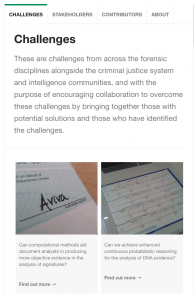
Felicity Carlysle of the KTN talks to CENSIS about the Forensic Science Innovation Database and how sensors have a particular role detecting and identifying different materials.
Forensic science is the application of science to the investigation and prosecution of crime. As such, there are a myriad of scientific techniques that can be applied in this area. Sensors have a particular role to play at the crime scene where there is a need to detect and identify different materials. However, the forensic market can be daunting to the uninitiated.
The Forensic Science Special Interest Group (part of the Knowledge Transfer Network) has created the Forensic Science Innovation Database, as well as a guide to taking your first steps in the forensic market to try and help stimulate further development in this area.
The database is free to access through the Forensic Science Special Interest Group. 
So what exactly is the Innovation Database? It is formed of three linked sections: challenges, contributors and stakeholders.
Challenges
The challenges are research challenges that have been identified by those involved in forensics, such as practitioners and academics. The challenges range from the day to day, such as how to improve swab technology, to blue sky thinking, such as using smells as investigative tools. The challenges are fully searchable via filters and key words and the database has been designed in such a way that you don’t need to be a forensic expert to find a challenge that interests you. Each challenge has a short description and a link to the individual who submitted it.
Contributors
Each contributor has their own page with contact details and a list of all the challenges they submitted. If you are interested in working to resolve a particular challenge it is recommended that you contact the relevant contributor to discuss the challenge further. In this way any research projects can be focussed firmly on the issue and therefore the outputs of the research are more likely to be taken forward to market.
Stakeholders
The final section is the stakeholders. These are companies, academic institutions and end users such as police forces, all of whom are active or have interests in forensic science research and development. Each stakeholder page contains contact information as well as details on capabilities and the types of partnerships that the stakeholder is interested in. If a member of the stakeholder has contributed challenges there will also be links to these and the contributor.
The combination of challenges, stakeholders and contributors means that the Innovation Database is a go-to resource for identifying new research projects. It can also help identify areas where your new innovation could be applied to forensic science.
You can have a look at the current challenges, contributors and stakeholders at the Innovation Database website.
Download the guide ‘Taking Forensic Science R&D to Market’
Felicity Carlysle is a Knowledge Transfer Manager with the Knowledge Transfer Network (KTN) based at the Roslin Institute in Edinburgh. The KTN was established to foster better collaboration between science, creativity and business and has specialist teams covering all sectors of the economy, from defence and aerospace to the creative industries, the built environment to biotechnology and robotics.
Twitter @fcarlysle @KTNUK